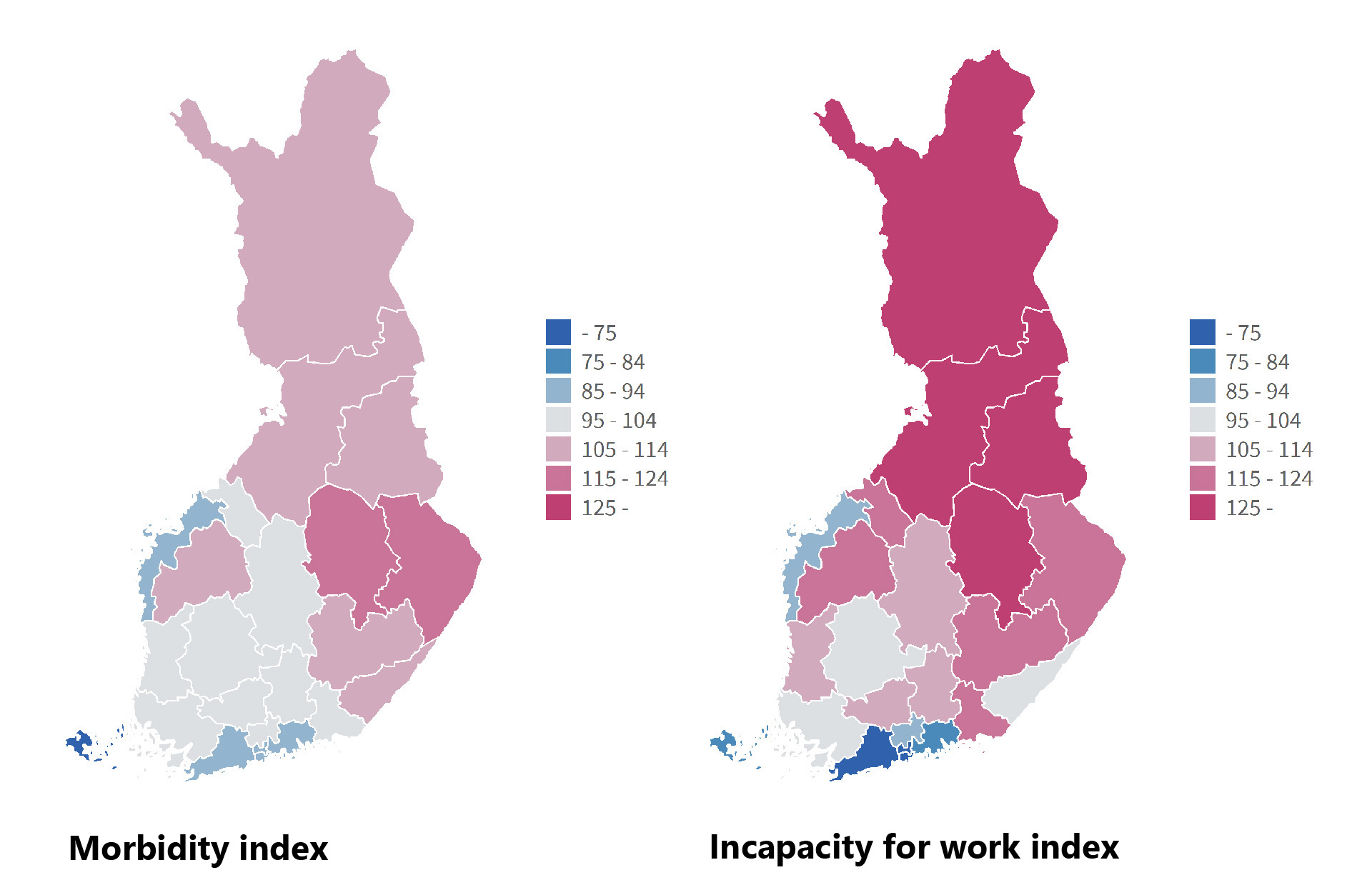Healthiest Finns live in Ostrobothnia and Uusimaa: morbidity and incapacity for work most common in North Savo
The healthiest Finns live in Ostrobothnia, wellbeing services counties of Uusimaa and Helsinki, while the unhealthiest live in North Savo and North Karelia. Incapacity for work is highest in North Savo, Kainuu and North Ostrobothnia and lowest in Uusimaa.
The differences between the wellbeing services counties are revealed in the National Health Index data, published for the first time, which are based on the register data for 2019–2021. The indexes and their different sub-topics comprehensively describe the prevalence of diseases and incapacity for work in the wellbeing services counties in relation to Finland’s population.

Differences in morbidity between the wellbeing services counties are particularly evident in the prevalence of severe mental health problems, alcohol-related diseases, musculoskeletal disorders and coronary heart disease in relation to the national average. The number of mental health and musculoskeletal disorders was clearly higher in North Savo in comparison to other regions and to the national level.
Alcohol-related morbidity was highest in North Karelia and clearly higher than in other regions also in South Karelia. Coronary heart disease was also more common in South Karelia than in other regions.
Incapacity for work data complements the picture of the health of Finns
The new index on incapacity for work included in the National Health Index describes regional differences related to disability pension, sickness allowance and vocational rehabilitation.
The share of those on disability pension was highest in Kainuu, North Savo and North Ostrobothnia. Receiving sickness allowance for more than 3 months is most common in Central Ostrobothnia, Kainuu and North Ostrobothnia.
The share of those granted vocational rehabilitation was highest in North Karelia, North Savo and South Savo and lowest in Eastern Uusimaa and Helsinki.
– There are differences between regions in terms of work capacity and access to incapacity benefits. The index reflects the work capacity of the population, but it is also affected by the availability of services. Applying for vocational rehabilitation depends on, among other things, how easy it is to access social and health services, how actively clients are directed to rehabilitation services and how different rehabilitation services are available. In particular, the question is whether there are enough physicians in the region, as you need to have a medical certificate to receive incapacity benefits. If there is a shortage of physicians in the region, the implementation of vocational rehabilitation is limited, says Kati Sarnola, Senior Researcher at Kela.
There are many factors behind morbidity and incapacity for work.
– In addition to services, regional differences are caused by a variety of factors, such as lifestyle, employment and economic situation as well as education. Cultural and genetic factors also play a role, Sarnola says.
Health Index dataset helps wellbeing services counties in the planning and evaluation of services
The National Health Index dataset describes the burden caused by diseases in the wellbeing services counties. The burden is assessed through mortality, disability pensions, quality of life impacts and costs for each disease group.
– The index data can be used in the planning and evaluation of measures that promote social and health services, social benefits and activities to promote well-being as well as health and safety, says Päivikki Koponen, Docent, Chief Specialist at the Finnish Institute for Health and Welfare (THL).
The developers of the index emphasise that decision-makers have the means to change the health situation. Particular attention should be paid to the socio-economically disadvantaged.
– The burden of diseases can be reduced by improving living conditions through education and employment measures. The most effective means rely on decisions that enable lifestyles that promote health and well-being, such as regional planning that encourages everyday physical activity and free or affordable sports services. It is also important to strengthen access and continuity in primary care, Koponen says.
Municipal data will be published in autumn
The Health Index data for each municipality and for the five collaborative areas will be published later this year. In the future, the data will be updated annually.
The Health Index data have been developed in extensive national cooperation. Data from the registers of THL, Kela, the Finnish Centre for Pensions and Statistics Finland are used in calculating the morbidity index, the index on incapacity for work and their sub-indexes. The dataset of the National Health Index replaces the prior Morbidity Index of THL and Kela's Health Barometer.
The results are affected by regional differences in population structure, possible shortcomings in the register data and health care activities. For example, a shortage of personnel in social and health services may cause delays in diagnoses or make it difficult to obtain the medical certificate required for granting benefits.
Contact information
Kati Sarnola
Senior Researcher, Kela
Tel. +358 20 635 7885
E-mail: kati.sarnola@kela.fi
Päivikki Koponen
Chief Specialist, THL
Tel. +358 29 524 8868
E-mail: paivikki.koponen@thl.fi